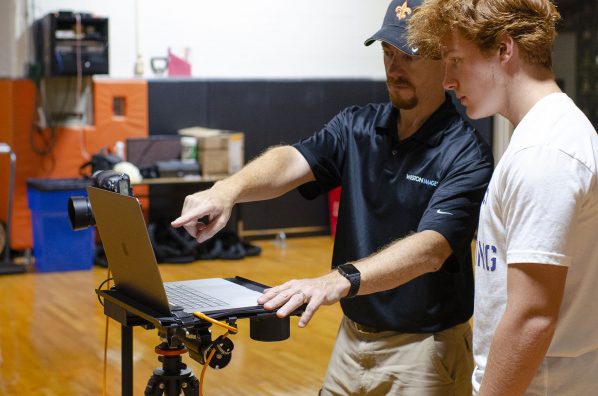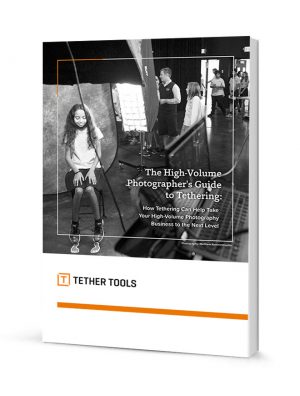

High-volume photography has traditionally been a manual process of shooting images to a memory card, uploading the images to a computer, organizing them, editing them, and then sending the image files off to a lab for printing. This workflow is time-consuming and can be prone to many errors and anxiety about data loss. The key to a successful high-volume photography business is having a workflow that allows you to produce consistent, high-quality images in an efficient manner.
Tethering offers many benefits for the high-volume photographer, speeding up their workflow, providing a way to consistently capture better-quality images, and offering accurate data management. Unfortunately, there are a few common misconceptions surrounding tethering, preventing some high-volume photographers from making the leap to tethered shooting to reap the rewards that would help take their high-volume photography business to the next level.
Common Misconceptions Surrounding Tethering in High-Volume Photography
Many high-volume photographers may be missing the key to speeding up their workflow with tethering due to a few of the following common misconceptions.
You could get too caught up in the details
Some photographers may think that if they tether, they might get too caught up in the details and spend too much time reviewing their image results and less time shooting. However, when a photographer doesn’t review the image results on a larger display while shooting, it can cost them more time in the long run if details are missed that have to be corrected in post-production.
Tethered shooting helps you avoid this problem by giving you the ability to view images on a larger display in high resolution as you shoot so that you don’t miss important details such as composition, lighting, focus, color, and exposure or specific details about your subject You can then make any necessary adjustments along the way to avoid unnecessary post-production and prevent a high number of retake sessions.
A tethering system requires AC power
Long days of tethered shooting to a laptop (and the need to often recharge your camera battery) do require AC power. However, there are now battery-powered workstation solutions that solve this problem. A Case Relay Coupler Bundle can be handy because it provides a way for you to power your camera through an external battery or a power outlet.
To keep your laptop and any USB-powered devices charged and running, the ONsite Versa V-Mount Complete Bundle 110V is the perfect solution. This kit includes a power supply that has four fast-charging USB ports and two AC outlets, an AC power supply car adapter, and a battery with a mount that attaches to your light stand.
Tethering cables and device cords could be a tripping hazard
Some photographers may conclude that tethering cords could be a tripping hazard, especially if they are shooting several feet away from their computer. Luckily, there are several cost-effective options in cable management that drastically reduce this problem, or you can implement a wireless tethering option such as the Air Direct Wireless Tethering System or the Case Air Wireless Tethering System, which allows you to tether wirelessly to a tablet or computer and eliminates this issue completely.
There’s too much extra equipment and gear to tote around
No photographer likes to carry more than what they need to a photography job, and although tethered shooting has always required some extra gear, technological advancements have reduced the amount of gear you need to reap the benefits of tethering for high-volume work. You can now set yourself up with as little as a tablet; a tablet mounting kit such as the AeroTab Master Kit, which attaches to your tripod; and a wireless tethering solution such as the Air Direct Wireless Tethering System or Case Air Wireless Tethering System, which allows you to tether your camera wirelessly to a tablet.
When you need a portable setup due to shooting space restrictions or your camera is located more than 30 feet away from your computer, the High Volume Wireless Tethering Kit provides the flexibility you need to get the job done, allowing you to shoot wirelessly to a tablet with a smaller footprint.
Other Reasons Why Tethering Is the Perfect Fit for High-Volume Work
There are many pieces that come with a puzzle; however, only certain pieces are the perfect fit for a good solution. Tethering was designed to help make high-volume photography an easier experience for a number of reasons, and here are a few more.
A faster workflow
When you shoot tethered, you also speed up your workflow in a few areas. First, you are shooting directly to a computer instead of a memory card, so you are bypassing the time-consuming task of transferring images from a memory card to a computer. Second, when you use software such as Smart Shooter in school or sports photography, you can use the barcode or QR code capture feature to automatically match up and embed each student’s ID into their respective image files, making data management easier and more accurate.
Finally, when you set up your capture preferences to shoot to a watch folder, you can automatically import images directly into a high-volume post-processing platform of your choosing, such as Flow by PhotoLynx, Darkroom, or Next Generation Photography Solutions, for editing before sending them off to a lab for printing.
A safer solution for image retention
Tethered shooting eliminates the need for memory card storage, which reduces your chances of losing your images. It also allows you to simultaneously back up your images to an external hard drive, or to the cloud, while you’re shooting, ensuring you have duplicate files should you need them.
Begin Growing Your High-Volume Photography Business
There have been several misconceptions surrounding tethering in high-volume photography, which has prevented some photographers from taking their high-volume business to the next level.
However, advancements in technology have provided a number of solutions, making tethering a viable option under any circumstances. Learn more about how tethering can help grow your high-volume photography business by downloading our free guide: The High-Volume Photographer’s Guide to Tethering.



